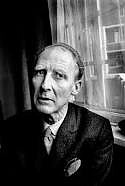BIOGRAPHY

1904-1983
Although born in Germany, to Russian parents, Bill Brandt’s pictures of British life and personalities, taken during and after World War II, have made him one of the country’s most esteemed photographers. Influenced by aspects of Surrealism as well as documentary, he ranged widely in his subject matter, exploring landscape and the nude in addition to portraiture. Above all, however, it was his feeling for social life – and for all types, from the working class to artists and writers – that lent distinction to his work, and made an important impression on photographers far beyond Britain, including the likes of Robert Frank.
It was the chance opportunity to photograph the poet Ezra Pound that gave Brandt the start he was looking for in photography: Pound arranged for him to work in Man Ray’s studio in Paris, in 1929 for three months. When he moved to Britain, in 1931, he was immediately struck by the character of the country and its people, and this became his focus.
After the war Brandt changed direction. He toured Britain to document the country’s most inspirational landscapes (Literary Britain, 1951) and he began to explore the female nude. He would continue to produce nudes for nearly three decades; his approach drew on Surrealist distortion, yet he put his own inimitable stamp on the genre, often eschewing eroticism in favor of highly abstract compositions and psychological drama. In time, Brandt came to see this as his most important body of work, and many of his best pictures in the genre are collected in Perspective of Nudes (1961).
Bill Brandt’s work was the subject of a major retrospective at the Museum of Modern Art in 1969 (touring to the Hayward Gallery, London, in 1970). And since his death there have been several more important shows, most recently in 2004, at the Victoria & Albert Museum, London. A biography, by Paul Delany, was published by Stanford University Press in 2004; numerous studies of his work have also appeared, including volumes by Ian Jeffrey, (Thames & Hudson, 1994), and Bill Jay and Nigel Warburton (Thames & Hudson, 1999). His work is represented in the major public and private collections throughout the world.
